Champaner
| Location: | Panchmahal District |
| Distance: | 159 km from Ahmedabad |
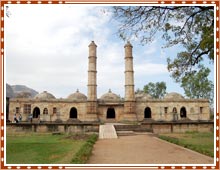
Champaner is an ancient fortified city of Gujarat. It is located at the foothills of Pavagadh, around 159 km from Ahmedabad. The city falls under the Panchmahal district of Gujarat. It is believed that the city derived its name either from the Champa tree or from Champaraj. Champaraj was the founder of the city and a contemporary of King Vanraj Chavda of Anhilwada. Tourism is slowly picking here and people are drawn towards exploring the historical town of the yore. In the late 15th century, Muhammad Begada, the Muslim King of Gujarat captured the fort of Champaner.
In 1484 AD, he decided to build the new capital of Gujarat here. It took 23 years to complete the construction of the massive project. Muhammad Begada finally named the town as Muhammadabad. It soon gained amazing popularity and was established as one of the glorious towns of western India. It became a major trade center dealing in fine silk, woven and dyed textile and sword manufacturing. After the death of Sultan Bahadurshah, the capital was shifted back to Ahmedabad.
Consequently, the town is dotted by the ruins of fort walls, tombs, gardens, arches, pillars and wells. There are a number of monuments in Champaner that are worth visiting. The royal palace of Muhammad Begada is one such building. Vada Talav is a huge lake situated near the citadel, which is a good place to relax. Amir Manzil is an excavated site containing a residential area, gardens, houses, water channels and three gates. The gates are Halol gate, Delhi gate and Godhra gate.
The major mosques found here are Shehar Ki Masjid, Jami Masjid, Kewada Masjid and Nagina Masjid. Jami Masjid, an architectural marvel of its times, is an imposing structure with high plinth, tall minarets and minutely carved gates and windows. Other worth watching buildings here are the ruins of Khapra Zaveri Palace, Atak gate, Makai Kothar, Kalikat Temple, Lakulish Temple. Kalikat Temple is a venerated Hindu pilgrimage for the devotees of Goddess Kali. Millions of people visit the temple every year.
 and moon. Lord Krishna's grandson, Vajranabha, is said to have built the original temple of Dwarkadhish over the hari-griha (Lord Krishna's residential place).
and moon. Lord Krishna's grandson, Vajranabha, is said to have built the original temple of Dwarkadhish over the hari-griha (Lord Krishna's residential place).

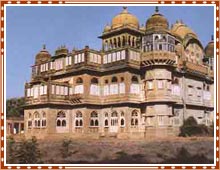 Kutch is the largest district in the state of Gujarat. It is the least populated owing to the fact that it is barren, covered with desert and marshland. Although it forms a major part of the state it has its own distinct identity. It is mostly inhabited by varied tribes. There are around 18 tribes living in the region which have their own discrete language and culture. This has made the place a paradise for the flourishing different cultures. It is a showcase of all the tribal culture of the region.
Kutch is the largest district in the state of Gujarat. It is the least populated owing to the fact that it is barren, covered with desert and marshland. Although it forms a major part of the state it has its own distinct identity. It is mostly inhabited by varied tribes. There are around 18 tribes living in the region which have their own discrete language and culture. This has made the place a paradise for the flourishing different cultures. It is a showcase of all the tribal culture of the region.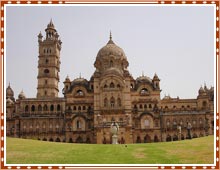 Vadodara city is the administrative headquarter of the Vadodara district in Gujarat. It is often termed as Baroda and is the industrial capital of the state. The city stands on the bank of River Vishwamitri, flanked by a number of graceful buildings like palaces, parks, temples and museums. This has greatly boosted tourism in Vadodara. The cultural galore of Vadodara impels visitors to travel to this historic city. In the ancient time, it served as the capital city of Gaekwads, the former rulers of Vadodara.
Vadodara city is the administrative headquarter of the Vadodara district in Gujarat. It is often termed as Baroda and is the industrial capital of the state. The city stands on the bank of River Vishwamitri, flanked by a number of graceful buildings like palaces, parks, temples and museums. This has greatly boosted tourism in Vadodara. The cultural galore of Vadodara impels visitors to travel to this historic city. In the ancient time, it served as the capital city of Gaekwads, the former rulers of Vadodara.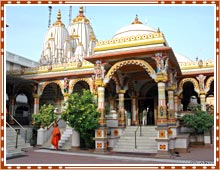 Gandhinagar is the capital city of Gujarat. It is located on the west bank of River Sabarmati, about 32 km from Ahmedabad. The city is named after the Father of the Nation, Mahatma Gandhi. After the partition of Gujarat and Maharashtra, it was decided to make a new capital for Gujarat. As a result, Gandhinagar was established in the vicinity of Ahmedabad. It is a well organized and architecturally integrated city and is slowly picking up as a tourism destination.
Gandhinagar is the capital city of Gujarat. It is located on the west bank of River Sabarmati, about 32 km from Ahmedabad. The city is named after the Father of the Nation, Mahatma Gandhi. After the partition of Gujarat and Maharashtra, it was decided to make a new capital for Gujarat. As a result, Gandhinagar was established in the vicinity of Ahmedabad. It is a well organized and architecturally integrated city and is slowly picking up as a tourism destination.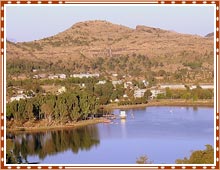 Saputara is a picturesque hill station situated in the Sahyadri Hills, which come under the Dangs District of Gujarat. The hill station serves as an added treat for the tourists who travel to the state. It is a perfect retreat from the hustling bustling city life and is popular from tourism point of view. The pleasant town offers utmost peace and tranquility. Amidst the lush green woods, one can rejuvenate and admire the chronicles of Mother Nature. The sightseeing tours of Saputara reveal much of its beauty.
Saputara is a picturesque hill station situated in the Sahyadri Hills, which come under the Dangs District of Gujarat. The hill station serves as an added treat for the tourists who travel to the state. It is a perfect retreat from the hustling bustling city life and is popular from tourism point of view. The pleasant town offers utmost peace and tranquility. Amidst the lush green woods, one can rejuvenate and admire the chronicles of Mother Nature. The sightseeing tours of Saputara reveal much of its beauty.









 Champaner is an ancient fortified city of Gujarat. It is located at the foothills of Pavagadh, around 159 km from Ahmedabad. The city falls under the Panchmahal district of Gujarat. It is believed that the city derived its name either from the Champa tree or from Champaraj. Champaraj was the founder of the city and a contemporary of King Vanraj Chavda of Anhilwada. Tourism is slowly picking here and people are drawn towards exploring the historical town of the yore. In the late 15th century, Muhammad Begada, the Muslim King of Gujarat captured the fort of Champaner.
Champaner is an ancient fortified city of Gujarat. It is located at the foothills of Pavagadh, around 159 km from Ahmedabad. The city falls under the Panchmahal district of Gujarat. It is believed that the city derived its name either from the Champa tree or from Champaraj. Champaraj was the founder of the city and a contemporary of King Vanraj Chavda of Anhilwada. Tourism is slowly picking here and people are drawn towards exploring the historical town of the yore. In the late 15th century, Muhammad Begada, the Muslim King of Gujarat captured the fort of Champaner.





 Vadodara also known as Baroda was the capital of the princely Gaekawad state in the pre-independence era. While in the post-independence era Vadodara became famous as a major hub of education and arts. Situated in the industrial corridor of Gujarat, Vadodara is emerging as the commercial and industrial capital of the state. Over the years a number of large and medium industrial units have come up in surrounding areas and the city's main avenues are lined up with a number of commercial complexes that rate among the best in modern architecture. Today Vadodara is an industrial city with some interesting museums and art galleries and a fine lush park. Popularly known as the City of Palaces and Gardens, Vadodara is home to a number of magnificent palaces and monuments which attract large number of tourists every year.
Vadodara also known as Baroda was the capital of the princely Gaekawad state in the pre-independence era. While in the post-independence era Vadodara became famous as a major hub of education and arts. Situated in the industrial corridor of Gujarat, Vadodara is emerging as the commercial and industrial capital of the state. Over the years a number of large and medium industrial units have come up in surrounding areas and the city's main avenues are lined up with a number of commercial complexes that rate among the best in modern architecture. Today Vadodara is an industrial city with some interesting museums and art galleries and a fine lush park. Popularly known as the City of Palaces and Gardens, Vadodara is home to a number of magnificent palaces and monuments which attract large number of tourists every year. These two monuments are located in south-east direction, outside the Amarthol Darwaja. Their religious importance has been described even in Skand Puran. Gauri Kund has been decorated with carving of large number of sculptures in varied sizes. Late Dr Kantibhai Sompura had written his study paper on these sculptures. The carving pattern of these sculptures is indicating that they were made during the Solanki era.
These two monuments are located in south-east direction, outside the Amarthol Darwaja. Their religious importance has been described even in Skand Puran. Gauri Kund has been decorated with carving of large number of sculptures in varied sizes. Late Dr Kantibhai Sompura had written his study paper on these sculptures. The carving pattern of these sculptures is indicating that they were made during the Solanki era.


